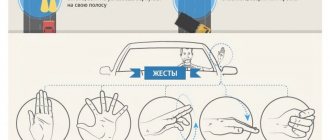The most annoying thing about being a person who always gesticulates heavily is that the more animated the conversation becomes, the higher the likelihood of knocking over a glass of red wine at the dinner table or accidentally hitting a stranger on the subway. Apart from the fact that gesturing brings success in interviews and dating, the above is further awkward evidence that gestures are cognitive - an idea supported by an impressive amount of psychological literature.
Traditionally, speech is thought of as a “private party” for the brain and larynx, with no room for the rest of the body. It’s not for nothing that the hosts of central TV channels are called “talking heads.” Thanks to René Descartes and a whole pantheon of other serious white men, Western intellectual history has long argued that thought is something that happens only in the realm of the brain. And as educator Ken Robinson once sarcastically noted, the body's job is only to carry the brain from one meeting to another. However, our hands indicate otherwise.
Gesture research
Susan Goldin-Meadow, a psychologist at the University of Chicago, has spent much of her career trying to understand what happens when people talk using their hands. She notes that a gesture that accompanies speech is different from an ordinary action, such as picking up a cup of coffee or combing one's hair, and it is different from a movement that is an end in itself, such as in a dance, ritual, or exercise.
The movements that hearing people make are also quite different from sign language. Goldin-Meadow says that usually in communication, units of expression and signs relate only to other signs. But in gesturing, hand movements are unclear, and they only make sense in conjunction with what is being said at that moment. “Gesticulation is not divorced from speech, it is completely tied to it,” says the psychologist in the journal Science of Us. “It’s part of learning, not just mindless hand waving.”
Researchers haven't yet been able to pinpoint exactly how this connection works, but Goldin-Meadow is confident that part of the connection is because gestures reduce what's called "cognitive load," or the amount of mental energy it takes to store data in working memory (a.k.a. RAM is a type of memory that determines the ability to “keep in mind” fragments of information necessary for momentary mental activity).
Goldin-Meadow began her career studying deaf children of hearing parents who are not exposed to standardized sign language and develop their own sign system. Since then, she has been researching the role of gestures in learning and speaking. Goldin-Meadow and colleagues found that when babies point to objects, they are more likely to remember their names; For adults, gesturing helps trigger memories when trying to remember a set of numbers, and for elementary school students to better understand mathematical principles.
The Origin of Nonverbal Communication
Perception - what is it in psychology
Nonverbal language has two types of origin: biological evolution and culture. Biologists have found that facial expressions when expressing emotions, most gestures and body movements in people are innate and serve as a signal for feedback. The biological nature of nonverbal communication is confirmed by elements not controlled subconsciously:
- paleness or redness;
- enlarged pupils;
- curvature of the lips;
- blinking.
Based on intentional and unintentional communication, there are 3 nonverbal means of communication:
- Behavioral factors. Caused by a physiological reaction: sweating from excitement, trembling in case of cold or fear.
- Unintentional means. Associated with people's habits (scratching temples, swinging legs, biting lips).
- Communication signals. Conveys brief information about an object, event, or state.
There are also universal signals known to everyone that are characteristic of a particular culture. Vivid examples are the style of behavior, dress code, and conventional signs of greeting and farewell.
Common “body signs”
Experiment
Action: We want to make one part (take the first two numbers - 2 and 9) equal to the second (put the numbers in the empty space).
Specific gesture: We want to make one part (we move our hands as if we are taking the numbers, but in fact we do not touch them) equal to the other part (we pretend to put the numbers on an empty space).
Abstract gesture: We want to make one part (we make a V-shaped gesture under the first two numbers) equal to the other part (we point to an empty space).
In this study, Goldin-Meadow and her colleagues divided 90 third-graders into three groups and tried to teach them the example of equality (2+9+4=__+4). In the “Action” group, students moved plastic numbers on the board following the instructor’s lead; in the “Concrete Gesture” group, children imitated the same actions, but did not touch objects; and in the “Abstract Gesture” group, students used V-shaped gestures.
Nonverbal communication what is it in psychology
Nonverbal communication is a type of communication without the use of words (through images, intonation, gestures, facial expressions). The tools for influencing a person are:
- sight;
- interpersonal space;
- optical-kinesthetic signals (facial expressions, appearance of the interlocutor, pantomime);
- peri-speech factors – vocal range, vocal qualities, timbre;
- extra-speech (laughter, speech rate, pauses).
For your information. Nonverbal methods of communication improve mutual understanding between people, allow you to predict the mood and attitude of the interlocutor towards the individual, and predict your own communication model.
Types of nonverbal communication
Gestures
Placebo effect - what is it in psychology
Nonverbal gestures include pronounced movements of the head, hands, fingers, accompanying statements and thoughts. If people need to pay attention to objects, they will need the help of pointing gestures. Emphasizing gestures reinforce statements. A demonstrative movement of the brush explains the state of affairs. Touching a partner helps to establish social contact or receive a sign of attention, weakening the significance of information. Gestures are performed in voluntary and involuntary forms.
Pose
Postures must follow the rules of etiquette. Open poses of a sitting girl in Europe and America have neutral meanings; in Japan they are considered immoral. The squatting position of adults in most countries has an indecent definition; in South America and Africa, many peoples rest in a similar form. Using a chair is assessed as aggression.
Poses of strength and weakness
Postures during a public address or business conversation should express openness: arms unclasped, legs uncrossed, back straight. If you lean forward a little, your posture will be perceived as interest in an understandable topic. Slouching communicates uncertainty, while wide-set legs and arms indicate dominance. Tapping with a hand or foot is a manifestation of boredom, lack of time, impatience. The interlocutor took a closed posture - this may mean that the person does not believe or does not perceive the information well. The legs are turned towards the exit, the person wants to leave. The head is tilted forward, the interlocutor listens carefully and analyzes.
Facial expressions
Facial expressions are commonly called expressive movements of the facial muscles in order to express certain feelings of an individual. The types of facial expressions correspond to the functions of the psyche: mental acts are expressed by the muscles around the eyes, the perioral muscles are associated with acts of will. Feelings are emphasized by the general muscles of the face, changing in conscious and involuntary forms.
Various forms of facial complexes are possible:
- Amymia is the absence of visible facial changes.
- Tension can be indicated by a tight closure of the mouth and a petrified state of the upper part of the face.
- Interest can be easily recognized by a slight raising or lowering of the eyebrows, a slight widening and narrowing of the eyelids. The field of view increases, the focusing of the eyes becomes sharper.
- A smile can refer to calming or distracting from aggressive behavior, and is used when greeting.
Facial expressions convey basic emotions (joy, sadness, anger, surprise, disgust), provided by innate neural programs, as well as false information.
Facial display of emotions
Distance
The norms of approach between two people are defined in science by four intervals:
- Intimate. A length of 0...45 cm is considered optimal for communication between close people.
- Personal. A gap of 45...120 cm is maintained when communicating with familiar people.
- Social. A distance of 120...400 cm is recommended for official negotiations and conversations with strangers.
- Public. At a distance of 400...750 cm, it is not considered rude to exchange a couple of phrases; this interval is observed when speaking in front of an audience.
According to the teachings of social science, the rules vary for people of different ages, gender, and social status. For example, children and old people stay closer to their interlocutor, compared to teenagers. Men occupy distant positions, unlike women. A calm person gets as close as possible, an unbalanced person stays further. People address interlocutors of higher status at a great distance. Nationality also plays a role. Asians interact over shorter periods than Europeans, city dwellers are closer to settlers in sparsely populated areas.
Intonation
Prosody (voice tone, timbre, sound intensity, pauses) regulates the flow of speech, complements or replaces statements, and expresses the emotional state. It is important to be able to hear the intonation structure of speech, evaluate the strength and tone of voice, speed of speech, expressing the feelings and thoughts of the interlocutor:
- excitement is manifested by a low tone of voice, fast, abrupt speech;
- enthusiasm is demonstrated by a loud voice and clear, confident speech;
- fatigue can be easily determined by a low tone of voice, weakening of intonation towards the end of a sentence;
- signs of arrogance can be slow speech, even monotonous intonation;
- uncertainty is felt by interlocutors who make mistakes in words, frequent pauses, and nervous coughing.
The voice contains a lot of information about the owner. Experienced voice specialists are able to study the age, place of residence, character and temperament of the owner. People who have the ability to dramatically change the pitch of their voice are more sociable, more confident and pleasant than monotone or uncertain interlocutors.
Clothes speak about a person
Cloth
When forming an image, a person tries on a role in society and internal positions. The key characteristic is not fashion, but the style direction and color scheme. Extroverts rely on bright, rich colors. Introverts choose dark tones, nondescript, halftones, black, bed, beige, gray. Bright and large jewelry can also be a means of demonstrating a person’s egocentrism and high status (or the individual himself desires it).
Gestures as indicators of the internal state of interlocutors
Gestures of openness. Among them are the following: open hands with palms up (a gesture associated with sincerity and openness), a shrug accompanied by an open hands gesture (indicating an openness of the being), unbuttoning a jacket (people who are open and friendly to you often unbutton their jacket during conversation time and even film it in your presence). For example, when children are proud of their achievements, they openly show their hands, and when they feel guilty or suspicious, they hide their hands either in their pockets or behind their backs. Experts also noticed that during successful negotiations, participants unbutton their jackets, stretch their legs, and move to the edge of the chair and table, which separates them from the interlocutor.
Gestures of protection (defensive). They react to possible threats and conflict situations. If we see that the interlocutor crosses his arms over his chest, we should rethink our actions or words, as he begins to withdraw from the discussion. Hands clenched into fists also mean the speaker is reacting defensively.
Evaluative gestures. They express thoughtfulness and dreaminess. For example, the hand-to-cheek gesture—people who rest their cheek on their hand are usually deep in thought. Gesture of critical assessment - the chin rests on the palm, the index finger is extended along the cheek, and the remaining fingers are under the mouth (waiting pose). A person sits on the edge of a chair, elbows on hips, arms hanging down freely ("That's great!" pose). A bowed head is a gesture of attentive listening. For example, if most of the audience does not lower their heads, this means that the group as a whole is not interested in the material presented by the teacher. Scratching the chin (the “well, let’s think about it” gesture) is used when a person is busy making a decision. The gesture towards the glasses (wiping the glasses, bringing the frame of the glasses to the mouth, etc.) is a pause to think, to weigh the situation before resisting more forcefully, asking for an explanation, or asking a question.
Reeling is a gesture indicating an attempt to solve a complex problem or make a difficult decision. Pinching the bridge of the nose is a gesture that is usually associated with closed eyes, indicating deep concentration, intense thought.
Gestures of boredom. They express themselves by tapping their feet on the floor or clicking the cap of a pen. Head in the palm of your hand. Machine drawing on paper. Blank look (“I look at you, but I don’t listen”).
Courtship gestures, courtship. For women it looks like this: straighten your hair, straighten your clothes, look at yourself in the mirror and turn in front of it, shake your hips, slowly spread and spread your legs in front of the man, stroke your calves, knees, thighs; balance shoes on your toes (“I feel comfortable in your presence”), for men - fasten a tie, cufflinks, jacket, straighten your whole body, move your chin up and down.
Gestures of suspicion and secrecy. Hand covering mouth - the interlocutor carefully hides his position on the issue under discussion. A side glance is an indicator of stealth. Legs or the whole body turned towards the exit is a sure sign that a person wants to end a conversation or meeting. Rubbing or rubbing your nose with your index finger is a sign of doubt (other variations of this gesture are rubbing your index finger behind or in front of your ear or rubbing your eyes).
Psychology of Gestures
Alan Pease, a famous psychologist, is called "Mr. Body Language." The author has published his works in millions of copies. Alana Pease set out to not only teach the reader to “decipher” body language, but also to apply the acquired knowledge in practice. Even the slightest changes do not escape his attention, up to the dilation of the pupils and the closing of the eyelids.
The author, analyzing the smallest details, identifies 2 important priorities.
Firstly, there is an opportunity to establish communications.
Secondly, it is possible with a high degree of probability to calculate a person’s further actions.
From the standpoint of psychological knowledge, Alan focuses on the distinctive features of behavior and gestures in women and men.
In addition to gender differences, the body movements of managers and subordinates differ sharply. Watching a conversation, you can record the rapid change of emotions.
How to learn to correctly recognize nonverbal signals
By learning to correctly interpret other people's nonverbal signals, you can expand your capabilities, raise nonverbal communication with your interlocutors to a new level, and also learn to recognize attempts to manipulate you.
In order to improve non-verbal communication skills, try to absorb when communicating, notice not only some noticeable, “large” gestures, but also note small ones, perceive the entire palette of human motor skills: facial expression, posture, posture, finger movements and gaze, shift intonation. This will allow over time to cut off superficial, conscious gestures of the interlocutor, identifying micro-expressions and noting signs of deception or unconscious lies. By noticing the broad gesture of your hands, you will also learn to notice the rapid licking of lips that betrays excitement, and then non-verbal communication with people will turn into an exciting ride in which attempts to manipulate you will be broken by your ability to recognize them and avoid them.
Nonverbal behavior and gestures
- If a friend is hunched over, this indicates that he has been severely offended or has experienced severe stress. The exorbitant “severity of the problems” does not allow him to straighten his shoulders. He feels discomfort because he cannot cope with the situation and thus closes down.
- If the interlocutor leans towards the speaker, this means that he is interested in the topic of the conversation. So he tries to get closer to the source of information.
- By tilting his head and simultaneously lowering his eyelids, the interlocutor expresses complete approval. There is no doubt about his respectful attitude. On the contrary, if a person often touches his face with his hands, touching his eyes or the corners of his mouth, he does not trust you.
- An individual's condition is revealed by his hands. When excited and irritated, it is common for a person to stroke himself, straighten his hair, or roll and fiddle with the first objects he comes across in his hands. Sometimes he puts his fingers in his mouth. In this case, he needs the support and approval of his opponent.
- Trust, openness, and willingness to cooperate are demonstrated by open palms. If he doesn't cross his elbows or legs, he will appeal to you. And if he puts his hands behind his back and raises his chin high, he thereby demonstrates his superiority.
- To convince your partner of a serious and responsible approach to further cooperation, you should use the following method. During business negotiations, it is necessary to mentally draw a potential partner a triangle between the eyes above the bridge of the nose and look into this area.
Proxemics
Proxemics is based on the construction of interpersonal relationships between individuals using spatial constraints. From the point of view of proxemics, nonverbal means of communicative communication include:
- Distance
- Orientations
- Distance
Psychologists have established several norms of “proximity” (spatial distances):
- Intimate – intended for the closest people (0-45 cm)
- Personal – allowing you to communicate with mutual friends (45-120 cm).
- Social – recommended for formal communication with unfamiliar people.
- Public – allows you to refrain from communication or speak in front of an audience.
An interlocutor who adheres to the above norms not only makes a favorable impression, but also feels more confident and comfortable.
These means of communication may vary depending on the nationality, social status and country of residence of the individual. Gender, age and personal characteristics of a person also matter.
Orientation
Such a proxemic component as orientation conveys various shades of a person’s emotional state, in terms of the angle of communication and the direction of the partner. Turning the toe and body can signal a person's attitude towards the opponent. A negotiator who decides to end the discussion involuntarily turns his body towards the exit. In business communication, seats at the negotiating table also matter:
- on the contrary, it characterizes a competitive-defensive position in which participants rigidly defend their point of view;
- on the one hand, it is the most convenient option for jointly discussing problems and developing a common solution;
- corner location - allows for a friendly and relaxed conversation;
- diagonally - the position indicates a lack of interest and reluctance of the participant in the conversation to interact.
Forms of verbal communication and barriers are not his way
When communicating verbally, we can use different forms and styles in order to convey certain information in a specific context and color. This can be clearly seen in the styles that are used in literature:
- Journalistic - the main goal of such a speech is to convey to people the idea, the essence of what happened.
- Scientific – distinguished by logic and clear statements using terminology and complex concepts.
- Official business is the dry language of laws, where everything is precise and without any epithets.
- Artistic - here it is possible to combine any words and word forms, jargons and dialect (dialectisms), speech is filled with unimaginable images and colors.
- Conversational - characterizes both individual dialogues in works and our communication with you when we meet an acquaintance.
Speech interaction can be divided according to the number of people who take part in it:
- Monologue (one person): speaking - at meetings in front of someone or reciting a poem in front of the class;
- report - important information, usually supported by numbers;
- report - similar to a report, but provides more extensive information and description;
- lecture – presentation of useful information to the audience.
Dialogue (two or more people):
- ordinary conversation - exchange of greetings and thoughts;
- discussion – discussion of a topic where the interlocutors represent different points of view;
- dispute – here, too, there are two positions between which the resulting conflict needs to be resolved;
- a debate is a discussion within the framework of science;
- interview - a conversation during which the employer thinks about whether to hire a person.
Despite the fact that we communicate in the same language, various barriers to verbal communication may arise:
For example, phonetic. The interlocutor may have a speech impediment, unpleasant diction, choose an unusual intonation, sprinkle words with parasites, etc... Semantic interference grows between people from different countries, with different mentalities, or even when raising children in different families. A logical barrier is if the interlocutors have different types of thinking, levels of development and intelligence. A stylistic barrier is that the interlocutor incorrectly builds a chain of verbal communication to convey information
First we need to attract attention to what we want to say, to interest. Then lay out the basic information; answer questions that your opponent may have
After this, give him time to think about it so that he can draw conclusions or make a decision.











